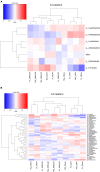Distinct Patterns in Human Milk Microbiota and Fatty Acid Profiles Across Specific Geographic Locations
- PMID: 27790209
- PMCID: PMC5061857
- DOI: 10.3389/fmicb.2016.01619
Distinct Patterns in Human Milk Microbiota and Fatty Acid Profiles Across Specific Geographic Locations
Abstract
Breast feeding results in long term health benefits in the prevention of communicable and non-communicable diseases at both individual and population levels. Geographical location directly impacts the composition of breast milk including microbiota and lipids. The aim of this study was to investigate the influence of geographical location, i.e., Europe (Spain and Finland), Africa (South Africa), and Asia (China), on breast milk microbiota and lipid composition in samples obtained from healthy mothers after the 1 month of lactation. Altogether, 80 women (20 from each country) participated in the study, with equal number of women who delivered by vaginal or cesarean section from each country. Lipid composition particularly that of polyunsaturated fatty acids differed between the countries, with the highest amount of n-6 PUFA (25.6%) observed in the milk of Chinese women. Milk microbiota composition also differed significantly between the countries (p = 0.002). Among vaginally delivered women, Spanish women had highest amount of Bacteroidetes (mean relative abundance of 3.75) whereas Chinese women had highest amount of Actinobacteria (mean relative abundance 5.7). Women who had had a cesarean section had higher amount of Proteobacteria as observed in the milk of the Spanish and South African women. Interestingly, the Spanish and South African women had significantly higher bacterial genes mapped to lipid, amino acid and carbohydrate metabolism (p < 0.05). Association of the lipid profile with the microbiota revealed that monounsaturated fatty acids (MUFA) were negatively associated with Proteobacteria (r = -0.43, p < 0.05), while Lactobacillus genus was associated with MUFA (r = -0.23, p = 0.04). These findings reveal that the milk microbiota and lipid composition exhibit differences based on geographical locations in addition to the differences observed due to the mode of delivery.
Keywords: delivery; fatty acids; geography; human milk; microbiome.
Figures





References
-
- Boersma E. R., Offringa P. J., Muskiet F., Chase W. M., Simmons I. J. (1991). Vitamin E, lipid fractions, and fatty acid composition of colostrum, transitional milk, and mature milk: an international comparative study. Am. J. Clin. Nutr. 53 1197–1204. - PubMed
-
- Brenna J. T., Varamini B., Jensen R. G., Diersen-Schade D. A., Boettcher J. A., Arterburn L. M. (2007). Docosahexaenoic and arachidonic acid concentrations in human breast milk worldwide. Am. J. Clin. Nutr. 85 1457–1464. - PubMed
Grants and funding
LinkOut - more resources
Full Text Sources
Other Literature Sources
Medical

